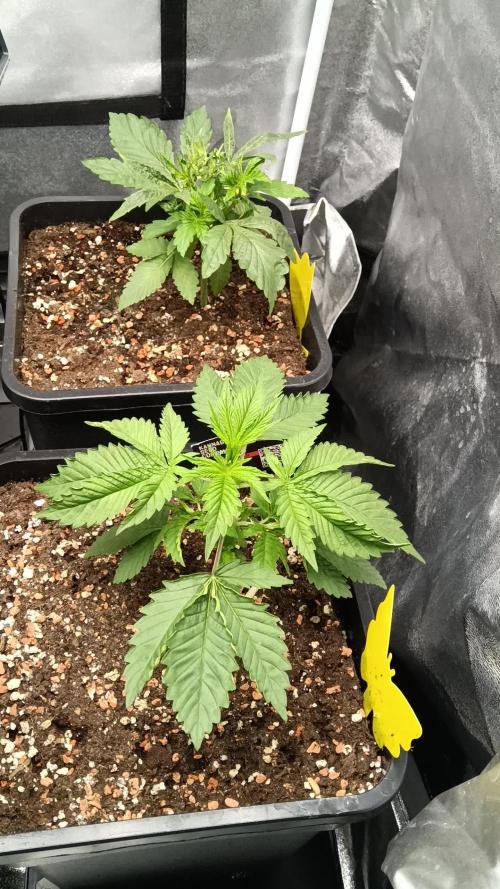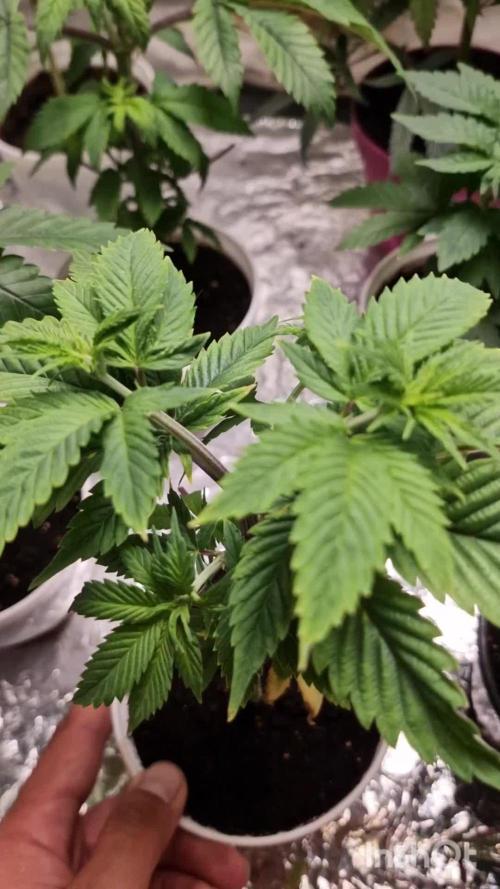The Grow Awards 2026 🏆 





























Likes
Comments
Share


@ChitownCannaChica
Follow
I can’t say enough! Terpy piney gas, frosty, yield, beautiful bud structure! Just a perfect plant all around. 🏻💚
Likes
9
Share


@HazeLiebhaber
Follow
Licht habe ich gestern auf 70% hochgedimmt.
Habe begonnen alle, außer der Amnesia, mit Hesi TNT zu füttern. Taste mich dabei langsam am die an die optimale Menge ran. Aktuell bekommt Lemon Orange die halbe empfohlene Dosis. KISS und Grapefuel Gelato bekommen etwas 20%. Bei der KISS werde ich die Dosis beim nächsten Mal noch mal erhöhen.
Lemon Orange wird außerdem heute ihr erstes LST bekommen.
Bei der Grapefuel Gelato gehe ich aktuell von einem Schaden durch die Hitze aus. Diese werde ich heute Abend wahrscheinlich Toppen. Die Hauptnodie wächst langsamer als manche Internodien. Die neuesten Blätter an der Hauptnodie sehen auch verkrüppelt aus und auch die der obersten Internodien. Die Blätter der unteren Internodien sehen soweit gesund aus, deshalb hoffe ich das Topping die Probleme löst.
Likes
23
Share


@RussianGrower
Follow
Recently, in the tent of my friend, we have prepared plants for the cultivation of guerrilla outdoor. Later, when the plants are already strong, you took them out and organized 5 plantations of several plants. They will grow themselves, with minimal care in the harsh Russian climate. The big danger for us now is not the police, and hunters for someone else's cannabis.
Who are the green hunters? These are bastards who do not grow cannabis, but steal other people's plants, they are ready for anything. When I was growing grass from my grandfather in the garden, I sometimes had to protect my plants at night with weapons, then I thought really to get a fighting dog, so that it bit off the uninvited guests eggs.
Now my grandfather is dead, and now I grow cannabis as a partisan and at home in a tent. But the memory of those times remained. In Russia, a terrible tradition to steal other people's bushes. Just imagine, you on your back brought water to the plants from the river, looked after and loved your plants, and a greedy hunter of greens cut your plants under the root, without waiting for their flowering. I'm willing to kill these bastards, I sometimes found myself on someone else's guerrilla plantations, but I never took everything, took samples on a couple of branches and prayed for this man when I smoked his weed.
Sometimes I hear from people that they steal other people's plants directly from private property from someone else's greenhouse, lulling someone else's dog. When I was drunk, I used to beat these people up really hard, because I had these green-hunter bastards stealing my weed, too.
In General, let's hope that our plantations will not be found, and the plants will be able to harvest. I really hope so, but I don't really believe it, because I've had such a bad experience many times, let's see how it will be this time. I hope with your moral support, the police and the green hunters will pass by our plantations.
Likes
3
Share


@spacetimeman
Follow
Some mold started to develop so I had to cut off two colas and harvested a bit too early.
Likes
9
Share


@LiamF
Follow
F***ing finally
she took forever
sadly dont have wet weight
Total dry weight is approx 70 Grams
smell is amazing! Shes have a more of a dark smell then the previous one.
Likes
27
Share


@Bread_n_Buds
Follow
Here we are again ready to start again, always under the sign of Zamnesia, we make our fantastic plants and we show you what we are capable of. We have 5 autoflowering strains and 5 photoperiodic ones and now we present them to you.
The fifth and last autoflowering for now of this round that we present to you is another classic of the classics always in the Zamnesia version. We have already grown it once and we sincerely hope to find the purple phenotype, Mythical mythological herb really in music and in everything, WE ARE TALKING
To explain my germination method which is a combination of experiences acquired in the field and readings of right advisors, I have chosen to divide it into phases so whoever wants can follow them and understand better step by step.
- Preparatory Phase ---- Check the average temperature in the room, humidity status to understand well whether it is the case to start or wait, I decided for the end of August because the temperatures start to drop towards the 22-25 degrees recommended for germination.
Then another thing more or less credible depending on the sensitivity is the control of the lunar phases. I believe in it a lot, it is a method that ancient farmers used to understand when it was best to plant depending on the attraction of the moon. To make my life easier I use a simple app that advises you on the right time to plant, harvest and put in a jar (depending on the lunar phases).
- Phase 1 --- Soaking in water. There are many authoritative friends who advise against this method due to the risk of drowning, but I have always been fine and I follow the rule if it opens in water almost certainly the seed is healthy and will come out of the ground 90% normally.
- Phase 2 --- Opening of the seed in water. As soon as the seed opens and the root comes out a little you have to be very very careful not to leave the seed in water open for too long. This is why there is a risk of drowning. So as soon as the root has come out it must be planted. Do not wait for it to stretch out too much, in the absorbent paper you can wait a little longer in water no.
- Phase 3 --- While I soaked the seeds I prepared my pots: I use small biodegradable pots (choose the ones with holes underneath for drainage). A few hours before working with the opened seeds I moistened the soil with water adjusted to the right pH (5.8 - 6.2) and Plagron Power Roots. The small root is now open and we can make a little hole with a toothpick, widen it and insert the seed. Not too deep with the root facing downwards. From Serious Seeds we learned the dome technique: if you put a small dome of soil on the seed the water will settle on the sides avoiding overwatering problems.
- Phase 4 --- The plant emerges from the soil. Up to now I have not put the light on, now I turn it on at minimum after half a day of soil to give direction to the seedlings. The first week the light will be gradually brought from 40% to 60% to go to 70% - 75% in the remaining weeks of veg. During the first week maximum, I keep the cycle of 24 hours to avoid stretching. Be careful not to exceed the first week at least with photoperiodic.
- Germination % --- In water 20/20 seeds have opened for good luck I'm waiting to talk when they come out of the ground but it seems that we are going towards an excellent percentage of germination..."Not too bad"...
- Soil and Food --- The soil used is entirely organic in every part and is the Plagron Promix that will be used with the 100% organic pack supplied by Zamnesia complete with all the main fertilizers for your plant buy it at the link --
https://www.zamnesia.io/it/11457-plagron-easy-pack-natural.html
// Strain Description // New Strain testing coming soon... -
- Get a seed of this fantastic strain --- https://www.zamnesia.io/
- Soil and Fertilizers entirely organic --- https://plagron.com/en
- Growbox --- https://www.secretjardin.com/
- Music and sound --- I made my girls listen to 432hz frequencies and music from www.radionula.com
- Z --- You can find these seeds, much more from the world of cannabis, mushrooms and an incredible series of accessories and gadgets on the reference site not only mine but of many growers ----
https://www.zamnesia.io
Likes
79
Share


@Salokin
Follow
Hello Growmies! 🌿👋
Welcome to Week 17 of our Epic Buzz journey! We're observing some noticeable progression in our plants, and we're nearly at the finish line with the next entry poised to be our final harvest week!
Here’s the breakdown for our Epic Buzz phenotypes:
Pheno #1 is thriving with its buds thickening up nicely, showcasing a frosty appearance that promises high-quality resin production.
Pheno #2 remains a bit smaller in comparison, yet it's catching up with an increase in bud density and trichome development.
Pheno #3 stands out with its robust growth and resin-packed buds that are slightly ahead in terms of maturity compared to its siblings.
As we approach the harvest, maintaining optimal environmental conditions—consistent humidity and temperature—is more crucial than ever to maximize their potential.
Stay tuned for our final week's update, and as always, stay lifted! 🚀🌱
Likes
10
Share


@farah4weed
Follow
Hello guys😍😍
Fifth week of growth.
Last week, the plants were a little shocked after topping, but after a few weeks they returned to normal growth.
To reduce this shock, I used BioEnhancer fertilizer.
And this week I checked the roots.
The pots are ready to be Transplat.Thank you for following my project.
🌷farah4weed🌷
Likes
5
Share


@Barksman
Follow
This is the current week which I decide to update from, so I will definitely keep it up as I recovered my account now 😅
This plant taught me never to allow nitrogen deficiency near a flowering plant😔
Likes
35
Share


@InhaleXhale
Follow
Nach langer Zeit ist es endlich soweit, ich habe sie geerntet.
Bei dieser Pflanze habe ich mich dafür entschieden sie gegen den natürlichen Lebenszyklus outdoor eher zum Blühen zu bringen.
Ich pflanzte sie in einen Hanffasersack den ich mit Erde auffüllte. Diesen platzierte ich auf einer Schubkarre.
Wo ich wohne wird es manchmal schon im Oktober sehr kalt, sodass die Wahrscheinlichkeit für eine sichere Ernte realtiv gering ist (at this point i hope the best for my other outdoor plants).
Ich rechnete mir aus wann der perfekte Zeitpunkt zur Ernte ist um noch im Sommer das Resultat genießen zu können.
Ab diesem Zeitpunkt fuhr ich die Schubkarre jeden morgen um 8 Uhr nach draußen und um 18 Uhr wieder nach drinnen um optimale 12 Stunden Lichtzufuhr zu gewährleisten.
Während den letzten Wochen der Blüte sind ein paar männliche Blüten aufgetaucht wie auch bei meinem indoor grow.
Für einige war der Zeitpunkt der Ernte vielleicht zu früh, aber ich finde es so sehr angenehm zu rauchen und auch der Effekt ist in diesem Stadium optimal für mich.
Die einzige Methode die ich hier verwendete ist das Pruning.
Es erspart dir einen Menge Zeit beim beschneiden der Blüten und lenkt die Kraft auf die verbleibenden Blüten, um diese zu stärken.
Nachdem ich bei meinem letzten outdoor grow viel zeit beim trimming verbracht habe, habe ich mir eine Erntemaschine gekauft (look at the video).
Mit dem Ergebnis der Maschine bin ich zufrieden, da ich es per Hand in der gleichen Zeit unmöglich in der Qualität geschafft hätte.
Die Blüten wurden ungefähr 2 Wochen bei guter Durchlüftung getrocknet, um am Ende wurden es 255g.
Für mich persöhnlich ist es ein sehr gutes Ergebnis.
Die Blüten sind schön fest und klebrig mit einem sehr süßlichen Geruch.
Ich habe versucht ein paar schöne Fotos zu machen und habe meine Kreativität spielen lassen (my wife also got a great idea, you can guess which idea was mine ;D)
If you have any questions feel free to ask. Im also open for criticism
I hope you enjoy the pictures and the report stay safe and happy growing.
____
i will update the smoke report soon.
Likes
10
Share


@FrulaFrulaki
Follow
Amazing growth this week, they've just exploded. The training was worth it as they're growing evenly, except for a few branches that I need to get under control. I probably won't install a net just because I'm a little late and don't see the benefits in this stage. Next thing I'm going to do is some cleaning up, defoliation to get them perfect for flowering.
Likes
36
Share


@Salokin
Follow
Hi all,
sorry for the delay, all continues to go very well, she is handling the nutrients very well wit only a very little tip burn. I increased the light a little bit, as I felt that some of the main colas on the side didn't get enough light.
Next week I will probably be able to show the little veg-box I built, since the cuttings are slowly outgrowing their current home.
Likes
58
Share


@AsNoriu
Follow
Day 64. Girls are going ok, but :
I had pH issues, recalibrated meter.
Have small thrips infestation, so bought 25000 Amblyseius swirskii, natural predators. Should be done deal !!!
One Cookie is going violet !!! Very nice, hard to reach to make clear photos, I will try better next week, she is really really nice!!!
Strawberry is going insane nuts, she crowned herself new QUEEN. Her top became triple top ;))) Beast not a strain !!!!
Happy growing !!!
Likes
7
Share


@Salgeezi
Follow
Well they germinated in record time for me..48 hours all 4 seeds. Medium is 50/50 coco/perlite. I watered the pots a day before planting. 250Ec. Been watering when pots feel light till runoff. Heat pad I had seemed to dry out pots quick. Temps and humidity are good. I switched from H&G coco to CANNA coco this round. It seems like cannas coco fibres are smaller and are holding more water then H&G. Therefore I believe I've been overwatering This entire week! FFS
Likes
31
Share


@The_Bearded_Grower
Follow
welcome to 📅 Day 50 : flower 5/3/2021. not to happy with the deficiency problems I'm having but she is growing well still. I will be dropping the amount of nutes to 1 mil a L from 2ml a L but leaving the cal mag the same.
I'm very happy with the MH TS 1000💡 and they plant also seams to agree
update 📅Day 52 : flower 5/5/2021 Not to much change it the problems yet but I have noticed she is getting fatter under the Mars Hydro TS 1000 she is loving the 💡 and I am too so lets see how she does.






























